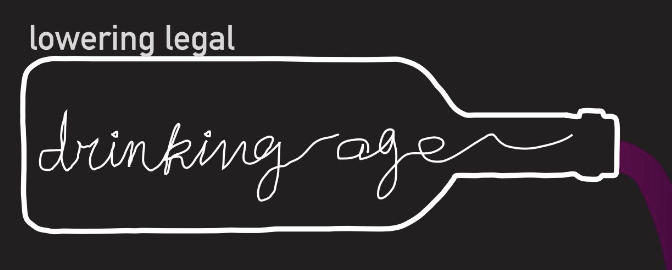Lowering Legal Drinking Age
March 28, 2020
Unlike some other points of contention in society, the minimum legal drinking age (MLDA) in America has not spurred walkouts, protests or other demonstrative events. Despite this, the fact that America has set its MLDA at the age of 21 is outlandish, and it should be lowered.
The minimum drinking age in America has a long winding history. After the repeal of prohibition in 1933, the US made the legal drinking age the voting age at the time, 21. When the US lowered the voting age to 18 in 1971, roughly 30 states lowered their MLDA to 18 as well. However, in 1984, Congress passed the National Minimum Drinking Age Act in an effort to reduce drunk driving, designating that all states have an MLDA of 21, and by 1988, all states did. Though some states have exceptions to the MLDA, the general age across America remains 21.
Although America has such a high MLDA, many countries around the world have much lower legal drinking ages, going as young as 14 for beer and wine (with a legal guardian present) in Germany. But no one is asking for America to go that low: most countries have their MLDA set at the age of majority in the country. A reasonable choice, given those considered legal adults are also granted several other rights. In America, the age of majority is 18. And while it used to be 21 in the 1930s, if the legal age of majority is currently 18, so should the drinking age.
Along with this logical line of reasoning, there are several fairly reasonable arguments as to why the legal drinking age should be lowered.
Lowering the drinking age allows young adults to learn to drink responsibility at home under the supervision of parents before going out into the world, minimizing the risk of them abusing alcohol consumption later on in their 20s. Parents would likely feel more comfortable knowing that their children understand the dangers of alcohol abuse and how to drink responsibly before moving out. In addition, lowering the legal drinking age allows those 18-21 to be allowed in safe drinking environments, such as bars and restaurants, as opposed to house parties and frat houses, places notorious for unsafe drinking.
Much of the “hype” from underage drinking comes from the fact that it is underage drinking. Those 18-21 often look towards alcohol as an act of rebellion, and reducing the MLDA limits the amount of rebellion allowed with the consumption of alcohol. Simply put, if what is now known as underage drinking no longer is underage drinking, the thrill of it ceases to exist.
One of the major arguments against lowering the MLDA is that keeping it high reduces the number of traffic accidents and fatalities due to drunk driving. At first glance, this appears to make sense: if the MLDA is high, fewer people can drive under the influence, and thus the amounts of accidents caused by drunk driving are lessened.
However plausible, the statistics say otherwise. According to the 2018 Global Status Report on Road Safety by the World Health Organization, about 31% of fatal car accidents in America involve alcohol. Compared to the much lower percentages of 4% in China, 29% in France, and 16% in the United Kingdom — all places with an MLDA of 18 — it is clear that a higher MLDA does not directly correlate to lower drunk driving accidents and deaths.
In addition, two years before America changed its national MLDA to 21, there was an overall decrease in the number of deaths caused by drunk driving in all demographics, despite the MLDA being only 18. This shows that the amount of drunk driving fatalities cannot entirely correspond to the MLDA and that other factors were involved.
Today, even with America’s current MLDA, it is no secret that underage drinking, particularly among college students, occurs on a day to day basis. This may not seem like that big of an issue, until the drinking gets out of hand. When underage drinkers abuse alcohol to the point of needing medical attention, many are hesitant to get necessary treatment due to potential legal repercussions. However, with a lower MLDA, teenagers would be more willing to receive the proper medical help as they would not have to face law enforcement for underage drinking.
Regardless of the concerns held around lowering the drinking age, the fact is that doing so causes little to no effect on society as a whole. Statistics prove that having a higher MLDA does nothing to prevent fatal accidents caused by drunk driving; a lower MLDA allows several currently underage drinkers to get medical help without worrying about legality; and most of all, it merely allows legal adults to be legal adults who are trusted under the eyes of the government. At the end of the day, there will naturally be people who will abuse a lower national MLDA; we know this because even with an MLDA of 21, underage drinking is still a prevalent issue in America.
People above the legal age of majority are allowed to vote, open bank accounts and even get sued, so why does drinking fail to make the list?




